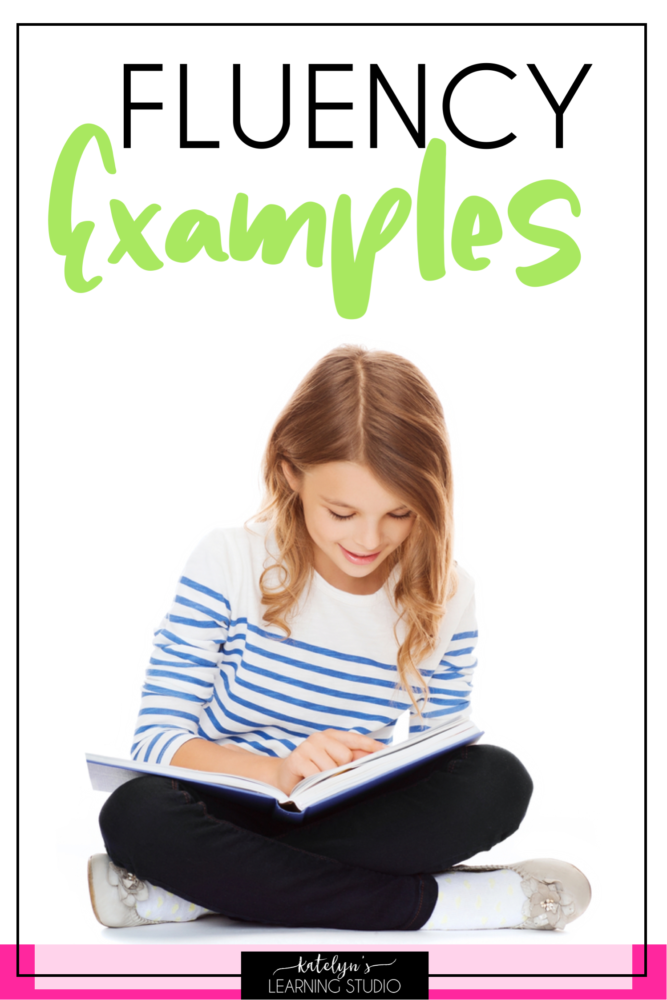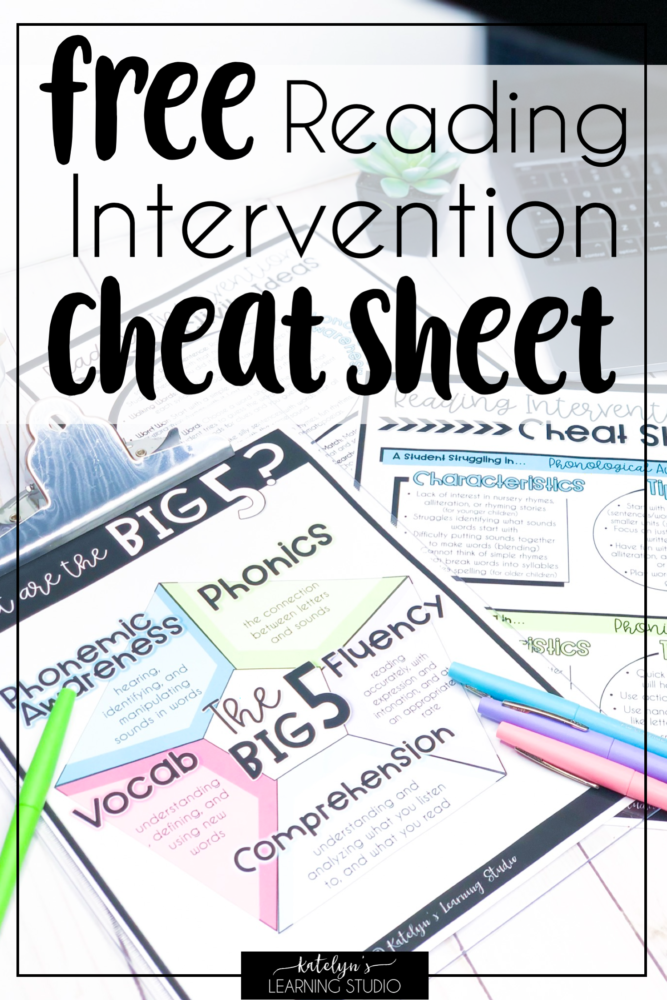Reading Fluency
What is reading fluency, and why is fluency important? Here’s everything you need to know about reading fluency and why struggling readers need it in their reading instruction.

What is fluency in reading and how can you develop it in struggling readers?
What is reading fluency?
-Fluency definition:
- Fluency means the ability to do something smoothly, easily, and accurately without much effort. The word comes from the Latin word “fluentem,” which means “to flow.” It’s often used to describe how people speak and use language.
Fluency in Reading
Just like someone being fluent in a language, people can be fluent in reading. Reading fluency is when you are able to read smoothly, easily, and accurately. When your reading flows without strained effort, just like when you are talking. It is one of the Big 5 Areas of Reading that you should include in your reading instruction (you can read more about that here).

Reading fluency is such an essential skill for struggling readers to build.
Fluency Matters
-Fluency and Comprehension
The skills fluency and comprehension are tied together. Reading fluency has a huge effect on whether students can comprehend the text or not. When students are reading slow and labored, they are not able to think about the overall meaning of the text. Often, students struggling with reading fluency are focused on sounding out each word and reading at such a slow pace, they have a hard time looking at sentences and paragraphs as a whole. They are just taking in one word at a time and not able to connect the words together to make meaning. When students are able to read with fluency, they can focus on the meaning of the text instead of figuring out the words of the text.
Check out this blog post for 8 strategies to help build reading comprehension!
-Reading Fluency Builds Confidence
Everybody likes feeling good at things. Reading fluently makes students sound and feel like real readers. Reading fluency boosts their confidence and encourages them that they are good at reading. They can hear themselves reading fluently and hear that they sound great. When students feel confident and that they are good at something, it is SO motivating! It makes them want to keep going. This confidence building is one of the 6 keys to making any intervention actually work.

This fluency definition covers the 4 components of fluency.
Reading Fluency Components
Some people assume that reading fluency is just reading fast. Let me tell you, it is so much more than that! Reading fluency has 4 main components that all work together to create a valuable reading experience.
-Speed
The rate, or speed at which the students read is the first part of reading fluency. Slow and laborious reading stalls comprehension, so you want students reading at a good pace. However, you do not want students zooming through the text just focused on how quickly they can read. It’s a balance! A good reading fluency rate is one that promotes comprehension and flow.
Part of speed is developing automaticity, or the ability to look at a word and know what it says without sounding it out. Automaticity helps students read more quickly, but also helps them focus on what words mean instead of what they say.
-Accuracy
A lot of people get confused with fluency vs accuracy. They assume that fluency is how fast you read and accuracy is how correctly you read. In reality, they are tied together! Part of reading fluency is how many words you read correctly. It’s important to tell students to make self corrections when they are reading, so they can get the right meaning. If they read a word that doesn’t make sense, go back and try it again. Help them to focus not on getting through as many words as they can, but to really look at the word their reading and make sure they are reading it right.
-Prosody
Prosody is the emotion and expression you use when you are reading. It’s reading phrases smoothly with intonation. Intonation is the pitch of your voice, so when it goes up and down. I love to use robot reading vs. talking reading to teach prosody. Robots talk one word at a time with no expression. In contrast, we talk in phrases and make our voice go up and down as we read.
-Comprehension
Comprehension is one more part of reading fluency that people often leave out. Even though comprehension is its own category of reading skill, it is also a major part of reading fluency. Just as we talked about above, reading quickly and accurately isn’t enough. Students need to understand what they are reading to be truly fluent. When someone is fluent in speaking a language, they aren’t just saying a bunch of random words. They know what they are saying and are carrying on a sensible conversation. They same goes for reading fluency. Students need to understand and think about what they are reading to read with fluency.

Fluency in reading can have many different forms in the classroom.
Reading Fluency Examples
So now that you have an understanding of what reading fluency is, here are some examples of what it looks like in the classroom. Here are 11 Tips to Boost Reading Fluency that go into more detail on some of these strategies.
Fluency Instruction
-Modeling
A great way to teach reading fluency is by modeling it. Each time you read aloud a story to your class, you are teaching fluency. Students can listen to what it sounds like to read fluently and keep that as an example of what to try to read like. Here is a list with some of my favorite read aloud suggestions you can use as you model good reading.
-Talking about it as you read aloud
More than just modeling, you can specifically talk about reading fluency as you are reading out loud. As mentioned above, demonstrate the difference between robot reading and fluent reading. Explicitly tell them that robot reading is when you read-one-word-at-a-time-like-this and your voice stays the say level. Literally talk like a robot as you read! Then tell them that fluent reading is when you read like you would normally talk. Tell them it is smooth, you read phrases at a time, and your voice goes up and down to match the emotion of the text, like when you talk. Then ask them to listen for fluent reading as you read out loud again.
Fluency Practice
-Choral Reading
Choral reading is a great way to practice reading fluency for struggling students and beginning readers who need a lot of support. Read together as a class or group, and make sure everyone is practicing reading smoothly and with expression. The “group mentality” is great for breaking students out of their shell if they are too shy to read with expression. If everyone is doing it, they’ll feel more comfortable! It’s important to make sure that each student is looking at the text and following along with their finger as you read, to make sure that everyone is participating.
-Partner Reading
Partner reading is another great option that students can do together. You can use partner plays (like these that I made for each holiday and season, or for more advanced readers you can use books like this one). These resources are laid out so that each partner has a “line” and they take turns reading. This fluency strategy is great for listening practice, modeling fluency, and peer feedback. Also, the text is broken up into shorter chunks, so it’s less overwhelming.
-Reading Aloud (guided reading, one on one)
This reading fluency strategy is for students to read out loud. Reading out loud is best when students are learning to develop reading fluency because they can hear themselves, the teacher can hear them and take note of progress, and it helps keep them focused on the text. Give students a lot of opportunities to read out loud with feedback and guidance, so during guided reading, pull students back for one-on-one reading if you have a few spare minutes, walk around the room during independent reading time and ask students to read to you from their book.
-Readers Theater
Another great example of fluency practice is practicing and performing readers’ theaters. Readers’ theaters are great because they give students a purpose for reading (to get ready for a performance), and a reason for repetition (practicing). Students are often excited to have their own part and perform, and thus engaged in reading. I have a ton of partner plays you can use as readers’ theaters for all year long. I love to use them in my guided reading groups. Assign half of the students in each group to a part, and then have students read their parts together with choral reading. We practice it all week and then invite parents in on Friday to watch us perform!
There is your overview of what reading fluency is, and what fluency instruction looks like in the classroom. Please remember that fluency matters! Fluency in reading is important to student reading proficiency, and it is so much more than just reading fast. As you explicitly model fluent reading to your class and give plenty of opportunities for fluency practice, you will see amazing growth in your students and they will find so much confidence as they build their fluency. For more reading activities that can help your struggling readers, here is my Ultimate List of Reading Intervention Activities you can check out.
After reading about fluency, if you feel that some of your students might need help in these areas, download this FREE Reading Intervention Cheat Sheet to help you identify which students need help and how to help them.

These reading intervention strategies and ideas will help your struggling readers!
Happy teaching and reading!
